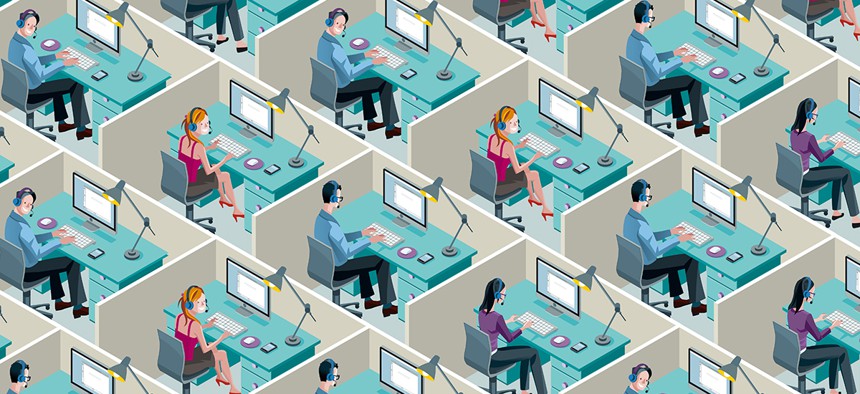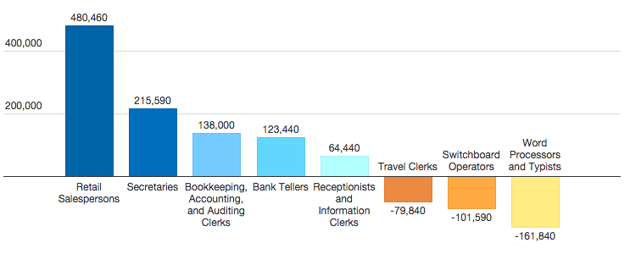
Jesus Sanz/Shutterstock.com
Scarce Skills, not Scarce Jobs
The "real" challenge technology presents isn't that it replaces workers, but rather displaces them.
At a large distribution center located north of Boston, a robot lifts a shelf holding merchandise and navigates it through the warehouse to the workstation of an employee who then picks the item needed for an order and places it in a shipping box. Incoming orders are processed by a computer that sends picking requests to sixty-nine robots. Then, the robots deliver storage units to roughly a hundred workers, saving the workers the task of walking through the warehouse to find the items. In other distribution centers, this is work that warehouse workers do.
The distribution center, run by Quiet Logistics—a company that fills orders for sellers of premium-branded apparel, is featured in the 60 Minutes episode “Are Robots Hurting Job Growth?” In the segment, Steve Kroft poses the following question to Bruce Welty, the CEO of Quiet Logistics: "If you had to replace the robots with people, how many people would you have to hire?" Welty estimates that he would have to hire one and a half people for every robot, and that the robots are saving him a lot of money.
Robots have long been a staple of science fiction. “Now they’re finally here,” Kroft tells us, “but instead of serving us, we found that they are competing for our jobs. . . . If you’ve lost your white-collar job to downsizing, or to a worker in India or China, you’re most likely a victim of what economists have called technological unemployment. There is a lot of it going around, with more to come.”
The robots perform tasks that humans previously performed. The fear is that they are replacing human jobs, eliminating work in distribution centers and elsewhere in the economy. It is not hard to imagine that technology might be a major factor causing persistent unemployment today and threatening “more to come.”
Surprisingly, the managers of distribution centers and supply chains see things rather differently: in surveys they report that they can’t hire enough workers, at least not enough workers who have the necessary skills to deal with new technology. “Supply chain” is the term for the systems used to move products from suppliers to customers. Warehouse robots are not the first technology taking over some of the tasks of supply chain workers, nor are they even seen as the most important technology affecting the industry today.

Information technology has been transforming supply chains for decades, often taking over tasks previously performed by shipping clerks and other workers. Systems track items from source to customer, keeping inventories at optimal levels and minimizing shipping time and cost. RFID (radio frequency identification) tags allow items to be tracked automatically, eliminating much clerical work. These technologies allow today’s retail stores to offer a far more varied selection than in the past, often at lower prices, and to respond quickly to changes in demand. They have changed the retail landscape, for example, powering the growth of Walmart, a pioneer in adopting some of these technologies.
Yet although these technologies eliminated some jobs for clerks and warehouse laborers, they also created new jobs by creating new capabilities. However, these new jobs require specialized skills among both the managers and technicians, who typically have college degrees, as well as among the less educated operational occupations. Workers who have these skills, often learned on the job, are actually in short supply.
Moreover, industry experts see the need for skilled workers increasing in the short run and persisting for at least another decade. Working with industry trade associations, academic experts issued a “U.S. Roadmap for Material Handling and Logistics,” arguing that:
Despite the potential of dramatically improved processes and technology for material handling and logistics systems in the coming years, much of the work in the industry will continue to be done by a human workforce in the year 2025. Moreover, other aspects of this [technology], such as mass personalization, will require levels of operational flexibility that can only be handled by a skilled and creative workforce. In other words, people will continue to be vital to the industry in 2025.
As with weaving and other nineteenth-century technologies, automation of some tasks increases the value of the remaining tasks, even as new or deeper skills are needed. But workers with those skills are not readily available, nor do robust labor markets initially provide the right incentives for workers to acquire those skills. The supply chain industry experts contributing to the U.S. Roadmap report say that a key challenge is to “overcome a perception that joining [the industry] might not result in a career with suitable rewards.”
Prospective workers are not likely to make investments in new skills if they don’t know where a particular job might lead them. No one wants to invest in skills related to technologies that will flop; career prospects for Segway repair mechanics are limited. The experts call for training programs with a new curriculum and certifications to standardize emerging job classifications. In their view, training certifications are essential to standardizing skills that will enable labor markets to provide long-term rewards: “On-the-job training will be required of companies in any feasible long-term solution. Nevertheless, there is a need to build a network of certifying bodies to incorporate certifications from associations and related programs in place today.” The experts call for these programs to generate 70,000 such certifications per year. As in the past, developing broad-based standardized skills are critical to employing new technology and creating well-paying jobs for large numbers of workers.
These problems posed by technology are not unique to supply chain workers. In their book The Second Machine Age, Erik Brynjolfsson and Andrew McAfee make a strong argument that technology is transforming work in a wide range of occupations. “There’s never been a worse time to be a worker with only ‘ordinary’ skills and abilities to offer, because computers, robots, and other digital technologies are acquiring these skills and abilities at an extraordinary rate,” they write. In the past, new technologies tended to automate blue-collar jobs. Now, information technology has begun automating even white-collar jobs, and the new technologies will increasingly automate jobs for highly educated professionals such as doctors and lawyers. Already computers can diagnose breast cancer from X-rays and predict survival rates at least as well as the average radiologist.
There is no doubt that technology is transforming work, but the question here is exactly how. The two perspectives described—one held by 60 Minutes and the other by industry managers—represent two different views of how technology is affecting jobs in the current economy. Both views recognize that technology takes over some tasks that humans performed. But one view contends that technology is not only taking over tasks, it is now eliminating work overall—thatmachines are replacing workers, leading to fewer and fewer jobs, especially for those without high levels of education. In this view, technology-induced unemployment keeps the median wage stagnant. A large pool of unemployed workers competing for too few jobs drives wages down.
In the other view, technology doesn’t replace workers; it displaces workers to jobs with somewhat different skill sets. Sometimes these new skills are employed in the same occupation; sometimes they are employed in new jobs in other occupations. But in this view, technology is not causing an endemic shortage of jobs except in very mature industries. Instead, wages are stagnant because it is difficult for many workers to acquire the new skills and labor markets do not fully compensate workers for those skills. In this view, skills are scarce and labor markets are incomplete; in the other, jobs are scarce.
The difference between replacement and displacement is important because it affects policy. If technology is replacing workers, then there is little that policy can do to overcome economic inequality short of drastic redistribution. On the other hand, if technology is mainly displacing workers rather than replacing them, the future, perhaps after a lengthy transition, might not be so different from the past. But achieving that future depends critically on putting in place the policies that will encourage broad-based development of new skills. A close look at actual trends in the labor market suggests a difficult transition is underway today rather than a sharp break with history.
It might seem obvious that when smart machines take over human tasks, jobs disappear. According to 60 Minutes, “bank tellers have given way to ATMs, sales clerks are surrendering to e-commerce, and switchboard operators and secretaries to voice recognition technology.” But that is not what actually happened. ATMs did not eliminate tellers. Instead, because banks could operate branch offices with fewer tellers, they opened more offices and the total number of tellers grew.
Bank Tellers vs. ATMs in the U.S. (in thousands)

Over the last decade, the number of retail sales clerks and secretaries has grown. There are fewer switchboard operators, but more receptionists.
Changes in Employment (1999-2009)

While technology takes over some tasks, it also increases demand for goods and services and hence increases demand for workers performing the remaining tasks. Instead of just eliminating jobs, new jobs are also created, sometimes in different occupations. The widespread deployment of computers in office occupations over the last three decades was accompanied by a 1.2% growth in jobs per year, even though some specific occupations such as switchboard operators lost jobs; healthcare jobs, which have also deployed computers, have grown at 2.5% per year. The total number of jobs in occupations that use computers has grown faster than the overall labor market. Computers have definitely not been replacing workers overall.
However, many of the new jobs require new skills. Bank tellers now need marketing skills, not just cash handling; secretaries do less typing, thanks to word processing, but they now also act as travel agents. In many of the new jobs, the required skills are difficult to learn, because the technology changes rapidly. When workers cannot easily acquire the skills that command good pay, their wages don’t grow. This—not massive unemployment—is why technology has contributed to stagnant wages for the last thirty years. While the unemployment numbers are down, over a third of businesses report difficulty hiring workers who have needed skills.
Perhaps new generations of artificial intelligence technology will change things in the near future. But, according to computer scientists, humans perform major tasks today that are not about to be taken over by machines. Artificial intelligence might also quicken the pace of change, intensifying the stress of switching to new jobs and learning new skills. But that is all the more reason for policies that can ameliorate the problems of displacement. A focus on the supposedly imminent end of work is at best a distraction from this challenge.
This article has been adapted from James Bessen's new book, Learning by Doing: The Real Connection Between Innovation, Wages, and Wealth.
(Image via Jesus Sanz /Shutterstock.com)






